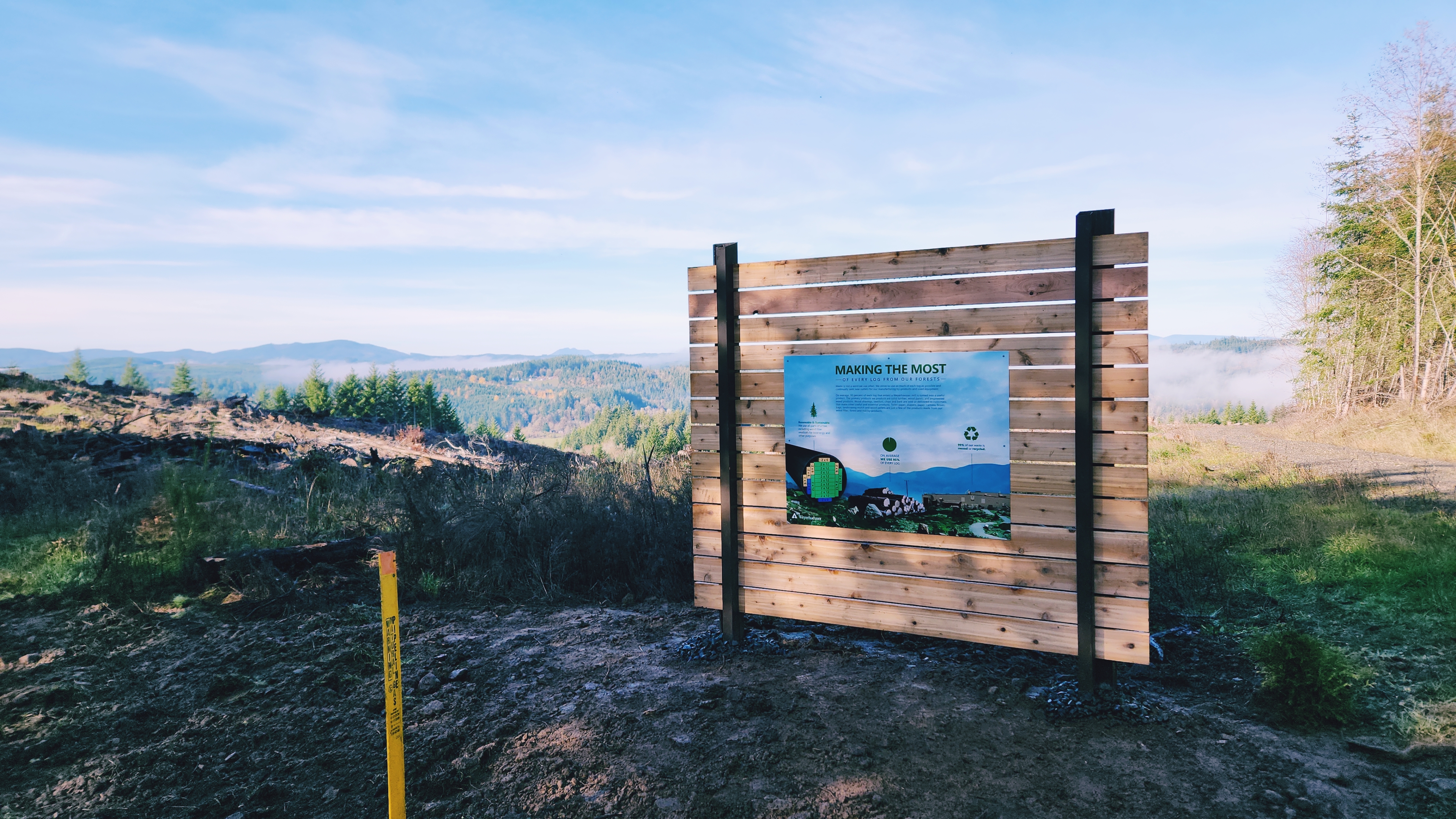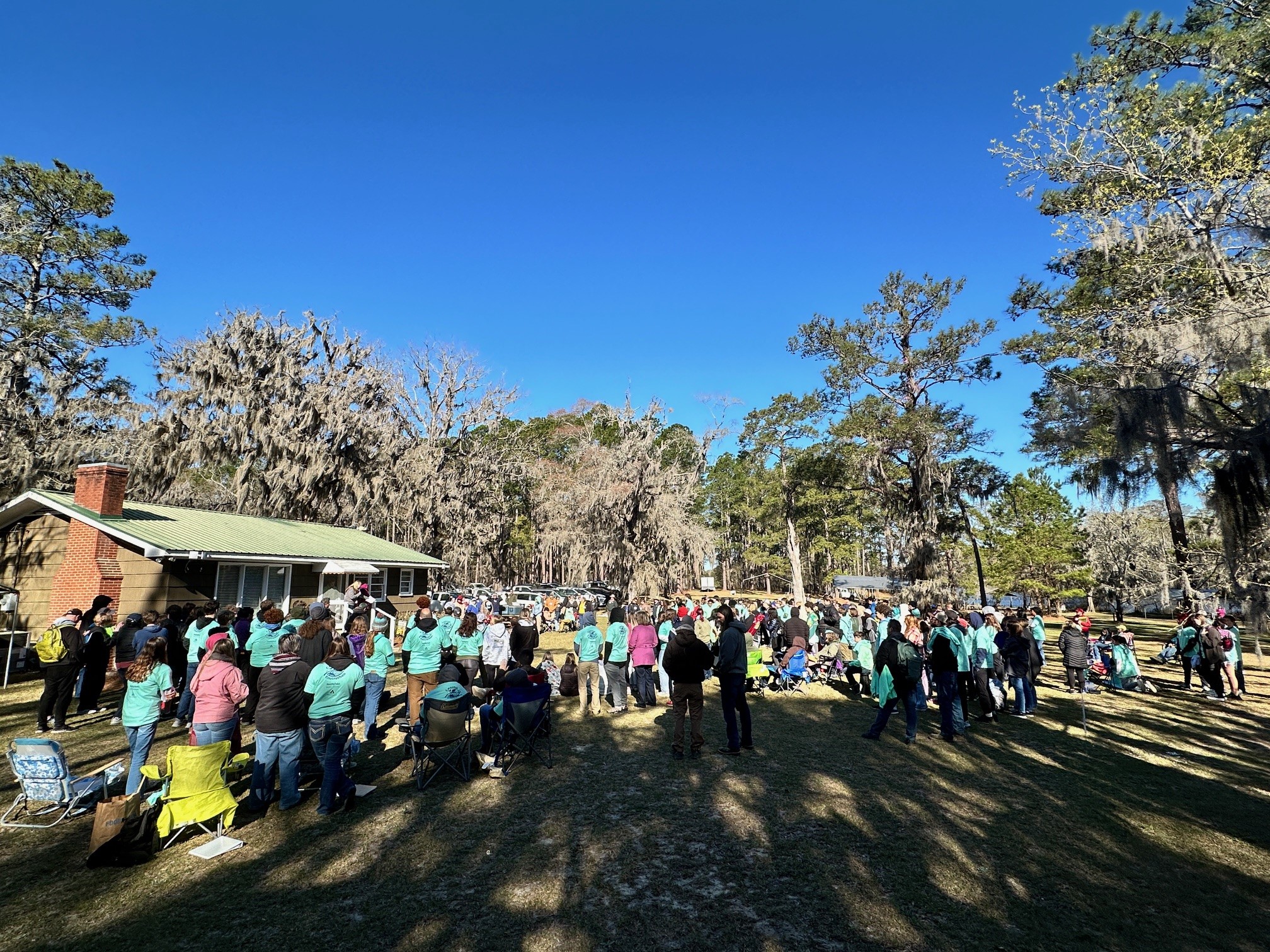
Our new log efficiency sign, situated on a hilltop on the Crown Z trail. 'Originally, we wanted the sign to depict a laser scan of a log that shows exactly how much lumber you can get down to the millimeter, because that’s the software we actually use,' Jeremy says. 'But that’s proprietary software, so we defaulted to a drawing that captures the message we want to send: around 95 percent of every log becomes lumber, and the other 5 percent is turned into useful by-products. Pretty much nothing is wasted.'
The Crown Z Trail meanders for 23 miles between the towns of Scappoose and Vernonia, Oregon, just northwest of the Portland metro area. Part paved and part gravel, the trail invites users to walk, hike, bike and ride horses up and down its length — including through part of our Northwest Oregon tree farm in Columbia County, Oregon.
Thanks to a collaborative project between our regional Timberlands team and the Crown Zellerbach Trail Advisory Committee over the past two years, those trail visitors can now learn about our working forests through a series of educational signs explaining different aspects of modern sustainable forestry. Installed by road crews last fall, the project was recently highlighted in a Western Timberlands Positive Environmental Impact Report.
“The Crown Z Trail signage project is a great example of employees working with outside partners to model our core values of citizenship and sustainability,” says Michelle Metcalf, Western Timberlands environmental management systems manager. “It’s exciting to see it come to life.”
Click to enlarge and read the sign.
A RICH AND STORIED HISTORY
Running along an old railroad track and part of a former logging road, the Crown Z Trail follows in the footsteps of the Clatskanie and Chinook tribes, who established a trail and inhabited the area long before the arrival of European settlers. In 1825, the Hudson Bay Company established Fort Vancouver on the north bank of the Columbia River, which became a shipping and receiving depot.
Settlers arrived in waves, establishing thriving logging, blacksmith and brick-making industries as well as small farms. The Portland and Southwestern Railroad was built along the trail’s route in 1906 to haul timber. It remained in use until 1944, when it was purchased by the Crown Zellerbach Corporation and turned into a logging road.
Columbia County completed its purchase of the long-disused road in 2004 and opened it up to the public. Historical sites along the modern-day trail include the remains of a Chinook plank house and camps used by Japanese railroad workers, which are pointed out by interpretive kiosks that help explain the history of the land the trail passes over.
The working forests sign is set in the thick of the woods.
A COLLABORATIVE CREATIVE PROCESS
The trail signage project began in 2022 with a call from Tony Hyde, a former logger and Columbia County commissioner who now serves on the Crown Z Trail Advisory Committee, who pointed out a subject gap in the educational signage.
“The trail gets heavy use, especially in the summer, and Tony thought it was a great opportunity to teach the public about how much forestry has changed in the last century,” says Jeremy Sapp, Northwest Oregon land use manager.
Jeremy looped in Steve Keniston, area manager, and Kyleigh Gill, Oregon public relations manager, to start brainstorming ideas. The trio hiked the trail together to view existing interpretive kiosks that explain the trail’s history, and to select sites on Weyerhaeuser property for new, forestry-specific signs.
Then, they collaborated with James Ferguson, lead designer, to create visuals and narratives covering three themes: Working forests, sustainable forestry, and log efficiency. Once the designs were approved by the Crown Z Trail Association, Kyleigh found a local sign manufacturer located in nearby St. Helens to produce them.
Click to enlarge and read the sign.
SIGNS OF THE TIMES
“We were very intentional about sign placement, because having messages tailored to each site makes the signs more interesting and effective,” Kyleigh says.
The log efficiency sign was placed on a hilltop clearing, where you can look out into the valley that once contained the world’s first electrified sawmill. In the foreground are areas where we’re actively harvesting trees.
“It’s the perfect place to take a break, catch your breath and read some interesting information about the setting,” Jeremy says.
The working forest sign, set in the thick of the forest, explains what a working forest is and how our forests absorb carbon from the atmosphere to help mitigate climate change.
The sustainable forestry sign can be found where the trail intersects a trickling stream. As visitors read about sustainable forestry practices such as maintaining stream buffers, they can gaze out at the stream banks and see what those buffers actually look like in action.
The sustainable forestry sign is set near a stream so visitors can learn about and see stream buffers at the same time.
ROOM TO GROW
The trail signage project brings together three major goals: Public education, community partnerships and sustainability.
“Weyerhaeuser owns 32 percent of the land in Columbia County, so it’s extra important for us to showcase how we care for the land and maximize the use of the trees we grow and harvest,” Jeremy says. “We’re excited for people to start seeing the signs as the weather warms up and activity picks up for the season.”
Kyleigh hopes this project can serve as a guide for additional signage on properties we own throughout the United States.
“We have so many great trails located on or adjacent to our land, including in working forests that are open to recreation users,” Kyleigh says. “The educational opportunities are practically limitless, and this kind of signage adds a lot of value for visitors.”
Click to enlarge and read the sign.

